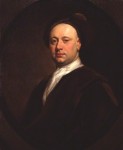 There are no confirmed portraits of William Shakespeare. Most of them were painted years after his death and there is little reason to believe they accurately reproduce the playwright’s features. The one with the best shot is the Chandos portrait. Painted between 1600 and 1610, a time when author portraits were increasingly popular among the moneyed literati, the Chandos portrait is not only the only extant portrait to have been painted during Shakespeare’s lifetime, but it has also been widely believed to be a portrait of the Bard since the mid-17th century when there were still people living who had known Shakespeare. None of the other contenders have so long a pedigree. It was hanging in Duke’s Theatre in London as a portrait of Shakespeare in the 1660s.
There are no confirmed portraits of William Shakespeare. Most of them were painted years after his death and there is little reason to believe they accurately reproduce the playwright’s features. The one with the best shot is the Chandos portrait. Painted between 1600 and 1610, a time when author portraits were increasingly popular among the moneyed literati, the Chandos portrait is not only the only extant portrait to have been painted during Shakespeare’s lifetime, but it has also been widely believed to be a portrait of the Bard since the mid-17th century when there were still people living who had known Shakespeare. None of the other contenders have so long a pedigree. It was hanging in Duke’s Theatre in London as a portrait of Shakespeare in the 1660s.
Its early history has come down to us from engraver and antiquarian George Vertue who filled 40 notebooks with his observations on art and artists of the time. Those notebooks, purchased after Vertue’s death by Horace Walpole who used them as the primary source for his five-volume Anecdotes of Painting in England, include a passage written in 1719 about the painting that would become known as the Chandos portrait.
Mr. Betterton told Mr. Keck several times that the Picture of Shakespeare he had, was painted by one John Taylor/a Player, who acted for Shakespear and this John Taylor in his will left it to Sr Willm Davenant. & at the death of Sir Will Davenant — Mr Betterton bought it, & at his death Mr. Keck bought it in whose poss. it now is.
 It’s hard to know how accurate this information is. Vertue had to rely on the recollections of Robert Keck, the owner of the portrait in 1719, and there is no independently verifiable source on the mysterious actor John Taylor who purportedly painted his boss. He doesn’t appear on any surviving records of Even if the ownership history is correct, there is no proof that the sitter was William Shakespeare instead of somebody else. John Taylor could have acted in Shakespeare’s company and painted other people.
It’s hard to know how accurate this information is. Vertue had to rely on the recollections of Robert Keck, the owner of the portrait in 1719, and there is no independently verifiable source on the mysterious actor John Taylor who purportedly painted his boss. He doesn’t appear on any surviving records of Even if the ownership history is correct, there is no proof that the sitter was William Shakespeare instead of somebody else. John Taylor could have acted in Shakespeare’s company and painted other people.
The portrait was inherited by Keck descendants until 1789 when one of them married James Brydges, 3rd Duke Chandos, who gave the painting its moniker. It remained in the Chandos line until 1848 when it was purchased by Francis Egerton, 1st Earl of Ellesmere, who donated it to the newly formed National Portrait Gallery in 1856. It was the first painting in the museum’s collection, hence its vanity plate-like inventory number of NPG 1.
By then, the portrait was viewed with suspicion by literary critics. Shakespearean scholar George Steevens said of a copy of the Chandos portrait that “our author exhibits the complexion of a Jew, or rather that of a chimney-sweeper in the jaundice.” Essayist James Hain Friswell cast doubt the sitter’s identity in similar racist terms. His argument amounted to that Shakespeare couldn’t possibly have looked like a dirty foreigner.
“One cannot readily imagine our essentially English Shakespeare to have been a dark, heavy man, with a foreign expression, of decidedly Jewish physiognomy, thin curly hair, a somewhat lubricious mouth, red-edged eyes, wanton lips, with a coarse expression and his ears tricked out with earrings.”
The difficulty in the identification of the sitter is compounded by the portrait’s extensive damage over the centuries. It was cleaned with excessive vigour, thinning the paint layers, and is coated in cracked and discolored varnish. Extensive retouching has materially altered the image, lengthening the hair and beard.
Now the NPG is seriously considering cleaning and restoring the portrait for the first time since it darkened the museum’s doorway. Outside specialists have recommended conservation, but the National Portrait Gallery’s trustees will make the final decision on whether to go forward next year.
The Chandos portrait has had no significant conservation treatment since its arrival at the gallery. A decision on cleaning has not yet been made but the work would involve the removal of discoloured varnish. The challenge for conservators will be to determine how much of the later additions to remove.
Most exciting, however, is the prospect that conservation work might provide further clues to determine whether the sitter is indeed the great dramatist—and how different the face was originally from what we see with the portrait’s present condition.
[youtube=https://youtu.be/Lskw_nW2IbQ&w=430]